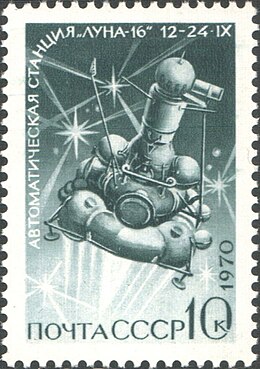 Stamp depicting a Ye-8-5 bus spacecraft | |
| Mission type | Lunar sample return |
|---|---|
| Operator | Soviet space program |
| COSPAR ID | 1969-058A |
| SATCAT no. | 4036 |
| Mission duration | 8 days achieved |
| Spacecraft properties | |
| Bus | Ye-8-5 |
| Manufacturer | GSMZ Lavochkin |
| Launch mass | 5,667 kg (12,494 lb)[1] |
| Dry mass | 2,718 kg (5,992 lb)[2] |
| Start of mission | |
| Launch date | 13 July 1969, 02:54:42 UTC[3] |
| Rocket | Proton-K/D |
| Launch site | Baikonur 81/24 |
| End of mission | |
| Destroyed | 21 July 1969, 15:51 UTC |
| Orbital parameters | |
| Reference system | Selenocentric |
| Lunar orbiter | |
| Orbital insertion | 17 July 1969, 10:00 UTC |
| Lunar impact (failed landing) | |
| Impact date | 21 July 1969, 15:51 UTC |
| Impact site | 17°N 60°E / 17°N 60°E[1] |
| Instruments | |
| |
Luna 15 was a robotic space mission of the Soviet Luna programme, that was in lunar orbit together with the Apollo 11 Command module Columbia.
On 21 July 1969, while Apollo 11 astronauts finished the first human moonwalk, Luna 15, a robotic Soviet spacecraft in lunar orbit at the time, began its descent to the lunar surface. Launched three days before the Apollo 11 mission, it was the second Soviet attempt to bring lunar soil back to Earth with a goal to outstrip the US in achieving a sample return in the Moon race. The previous mission, designated E-8-5-402, launched 14 June 1969, did not achieve Earth orbit because the third stage of its launch vehicle failed to ignite. The Luna 15 lander crashed into the Moon at 15:50 UT, hours before the scheduled American lift off from the Moon.[4]
- ^ a b Cite error: The named reference
solarsystem_nasa_govwas invoked but never defined (see the help page). - ^ "NASA Space Science Coordinated Archive: Luna 15". Retrieved 21 June 2022.
- ^ Siddiqi, Asif (2018). Beyond Earth: A Chronicle of Deep Space Exploration, 1958–2016 (PDF) (second ed.). NASA History Program Office.
- ^ "Russian spacecraft landed on Moon hours before Americans". The Daily Telegraph. London. 4 July 2009. Retrieved 17 July 2019.